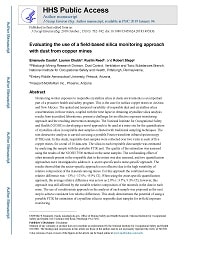Mining Publication: Evaluating the Use of a Field-based Silica Monitoring Approach with Dust from Copper Mines
Original creation date: October 2018
Authors: E Cauda, L Chubb, R Reed, R Stepp
Monitoring worker exposure to respirable crystalline silica in dusty environments is an important part of a proactive health and safety program. This is the case for surface copper mines in Arizona and New Mexico. The spatial and temporal variability of respirable dust and crystalline silica concentrations in those mines, coupled with the time lapse in obtaining crystalline silica analysis results from accredited laboratories, present a challenge for an effective exposure monitoring approach and the resulting intervention strategies. The National Institute for Occupational Safety and Health (NIOSH) is developing a novel approach to be used at a mine site for the quantification of crystalline silica in respirable dust samples collected with traditional sampling techniques. The non-destructive analysis is carried out using a portable Fourier transform infrared spectroscopy (FTIR) unit. In this study, respirable dust samples were collected over two visits to each of five copper mines, for a total of 10 data-sets. The silica in each respirable dust sample was estimated by analyzing the sample with the portable FTIR unit. The quality of the estimation was assessed using the results of the NIOSH 7500 method on the same samples. The confounding effect of other minerals present in the respirable dust in the mines was also assessed, and two quantification approaches were investigated to address it: a sector-specific and a mine-specific approach. The results showed that the sector-specific approach is not effective due to the high variability of relative composition of the minerals among mines. For this approach the combined average relative difference was −13% (−17.6%,−8.9% CI). When using the mine-specific quantification approach, the average relative difference was as low as 2.8% (−3.7%, 9.3% CI); however, this approach was still affected by the variable relative composition of the minerals in the dust in each mine. The use of a multivariate approach on the analysis of each sample was proposed as the next step to achieve consistent low relative differences. This study demonstrates the potential of using a portable FTIR for estimation of crystalline silica in respirable dust samples for in-field exposure monitoring.

- A Comparison of Respirable Crystalline Silica Concentration Measurements Using a Direct-on-filter Fourier Transform Infrared (FT-IR) Transmission Method vs. a Traditional Laboratory X-ray Diffraction Method
- Direct-on-Filter alpha-Quartz Estimation in Respirable Coal Mine Dust using Transmission Fourier Transform Infrared Spectrometry and Partial Least Squares Regression
- Direct-on-filter Analysis for Respirable Crystalline Silica Using a Portable FTIR Instrument
- Evaluating Portable Infrared Spectrometers for Measuring the Silica Content of Coal Dust
- Improving Silica Dust Control Through Targeted Research
- Laboratory Comparison of New High Flow Rate Respirable Size-Selective Sampler
- Reducing Silica and other Respirable Hazards in the Industrial Minerals and Metal/Nonmetal Mining Industries
- Respirable Size-Selective Sampler for End-of-Shift Quartz Measurement: Development and Performance
- Selected Publications on EVADE Software, Helmet-CAM, Dust Exposure, and Behavioral Studies
- Technology News 463 - Machine-Mounted Continuous Respirable Dust Monitor